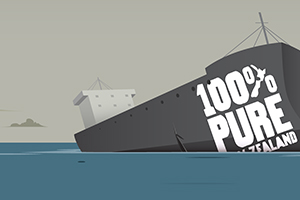
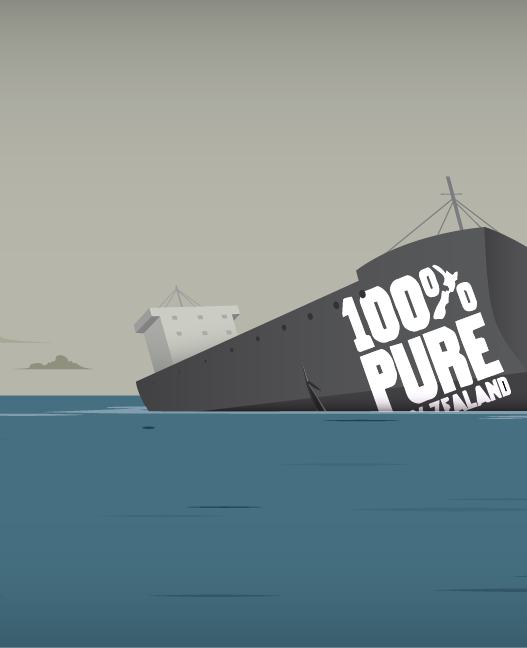
“We spent 25 years doing virtually nothing”
The inside story of why New Zealand is one of the developed world’s worst laggards when it comes to combating climate change.
By Veronica Meduna
Helen Plume’s at grandchildren live next door to her home in Plimmerton, 30 minutes north of central Wellington, and often wander in to see her, but for two weeks in August, she asked them not to come knocking at the door in the afternoons. She couldn’t be disturbed because she had to discuss the future of the planet.
Plume has taken part in almost every international climate meeting on behalf of New Zealand in the past three decades. She is the head of our delegation to the Intergovernmental Panel on Climate Change, the United Nations body that releases regular assessments of the state of the climate. The recent deliberations were held virtually, and she spent 10 nights in 12- hour Zoom marathons in her small home office at the end of the hallway. As she helped negotiate detailed descriptions of how our planet has already changed, it was clear that the future her grandchildren will inherit hinges on decisions we make now.
In its starkest warning yet, the IPCC confirmed that only steep, fast and lasting cuts to greenhouse gas emissions can prevent global warming from creeping irretrievably beyond 1.5°C. Since its first report in 1990, the IPCC’s progressively more certain projections have now materialised in the devastating realities of deadly heatwaves and floods, rising seas and melting ice.
Plume has also long led New Zealand’s emissions inventory, a detailed account of greenhouse gas emissions from each sector, updated each year — and a record of how badly the country has failed to tackle climate change so far.
Of 45 industrialised nations, 34 have managed to reduce their gross emissions — that is, the total amount of greenhouse gases they produce. A smaller group, including the United Kingdom and Germany, have brought emissions well below 1990 levels. New Zealand is part of the remaining number whose gross emissions have increased between 1990 and 2019, by 26 per cent, despite our high share of renewable electricity. Our net emissions — which take into account the carbon-storing capacity of forests and soil — are no better. By that measure, New Zealand is fourth from the bottom, with a 34 per cent rise since 1990. On a per-capita basis — the standard we often use to trumpet cross-country comparisons and Olympic medal tallies — our gross emissions are more than twice the global average.
And there’s no sign yet of a consistent, let alone permanent, decline. Last December, Prime Minister Jacinda Ardern declared a climate emergency. But imports of low-grade coal are expected to reach a record high this year, to make up for lower-than-usual rainfall at hydropower lakes and dropping natural gas supply.
In 1990, New Zealand’s emissions of carbon dioxide were almost net zero! The goal we are now struggling to reclaim.
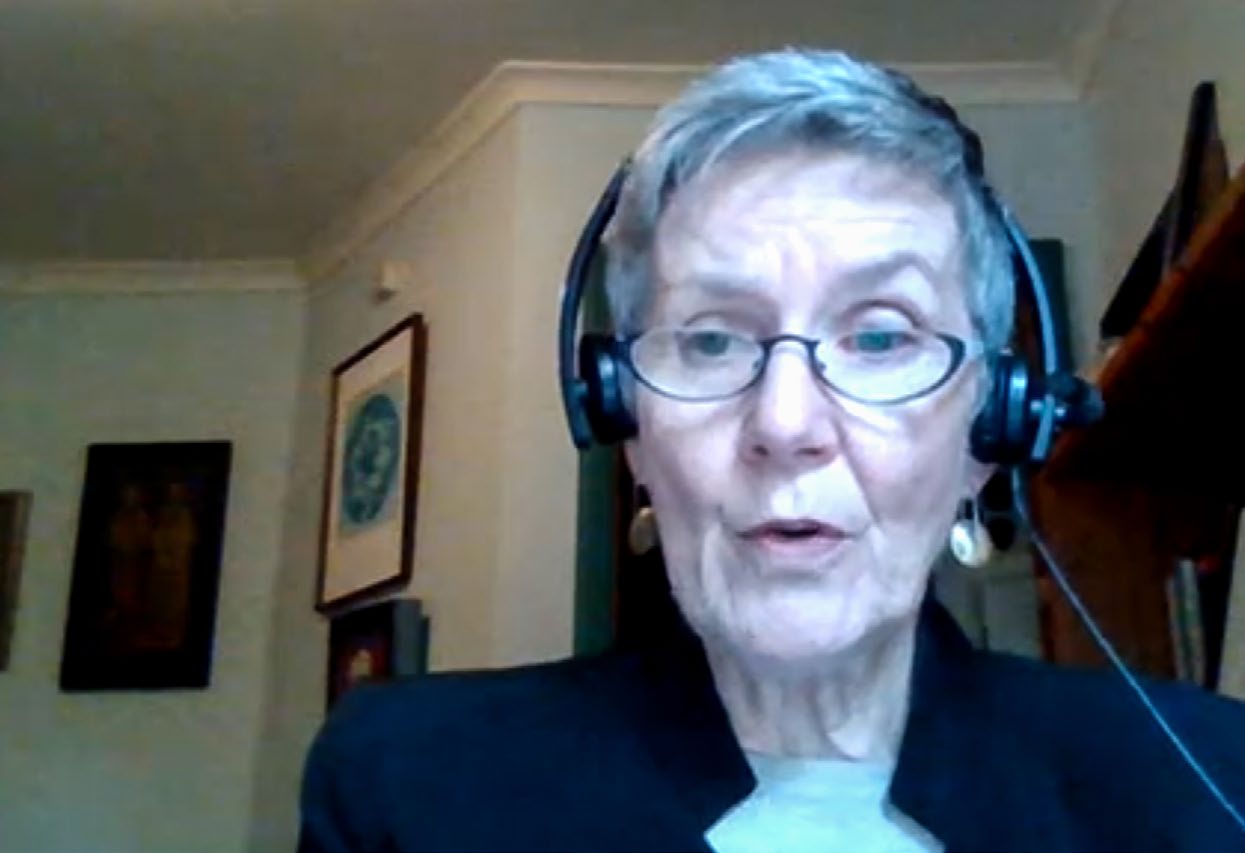
Helen Plume on a Zoom call during the 2021 Sessions of the UNFCCC Subsidiary Bodies, 7 June 2021. Photo: IISD/ENB
New Zealand’s 2019 Zero Carbon Act requires us to reach net zero emissions for long-lived greenhouse gases by 2050, along with phased cuts to methane. In June, the Climate Change Commission released a comprehensive roadmap of how we can get there without breaking the economy. The government has until the end of this year to produce a plan in response.
The same act also commits New Zealand to keep warming below 1.5°C, in line with the Paris Agreement. Our pledge is to cut 30 per cent of our 2005 emissions by 2030 — but that is insufficient to meet the 1.5°C goal and already unachievable through domestic cuts alone. This has the government scrambling. It may review our commitment before the next climate summit in Glasgow this November, but even as it stands, it can only be achieved by spending billions of dollars on offshore mitigation, paying other countries for reducing their emissions as a price of our failure to reduce ours.
But when you use Plume’s emissions inventory to go all the way back to 1990 — the year that has become the baseline for so many vital targets — you’ll discover something that may seem startling. Back then, New Zealand’s emissions of carbon dioxide were almost net zero — the goal we are now struggling to reclaim.
Not only that, but the government’s plan at the time was to cut emissions by a further 20 per cent within a decade. Prominent members of both parties were eager to see the country take a leading role internationally in the fight to reduce global warming. In fact, the first mention of global warming in Parliament came a few years before the IPCC even published its first assessment — by Simon Upton, then a National MP, now parliamentary commissioner for the environment.
So how exactly did New Zealand become one of the developed world’s worst climate laggards? It’s a story of frustrated ambitions, missed opportunities, intense lobbying and complicated environmental accounting. Or, as Upton puts it with a sense of resignation, the history of climate policy in New Zealand is about “people finding reasons not to do things”.
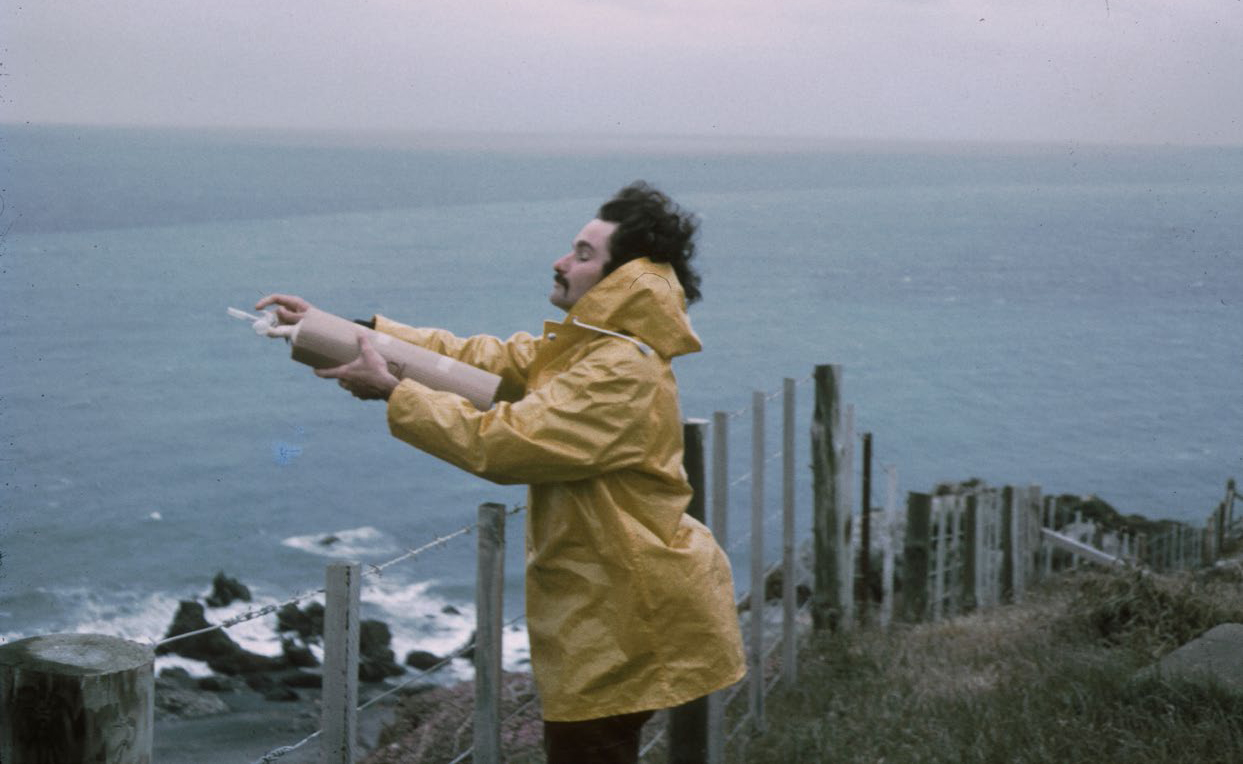
Dave Lowe taking an air flask sample at the edge of the Baring Head cliff in 1972. Photo: NIWA.
In March 1988, a group of scientists and officials gathered at a hotel in Wellington to discuss how New Zealand should respond to the challenge of a warming planet. It was still two years before the IPCC would confirm a clear link between rising greenhouse gas emissions and global warming. But the people in attendance were already attuned to the threat.
Helen Plume was there in her role as a policy adviser for the Ministry for the Environment, as well as David Wratt, a research manager at the meteorological service (now MetService) who would end up defending New Zealand’s climate data in court. And so was Dave Lowe, a keen surfer and atmospheric scientist who, at 23, had helped set up the Southern Hemisphere’s longest-running carbon dioxide monitoring station in 1972 at Baring Head, a remote peninsula buffeted by harsh winds at the bottom of the North Island. After years of exhausting, solitary work, he was among the first people in New Zealand to recognise the consequences of climate change.
The group canvassed topics that are all too familiar today: sea-level rise, changes to agriculture and ecosystems, extreme weather and renewable energy. There was a sense that ambitious change was possible. This was the year after David Lange had declared New Zealand a nuclear-free zone. The Montreal Protocol, phasing out substances that destroy the ozone layer, had become the first environmental treaty to be adopted by every member state in the UN. “There was a signal of hope,” says Sir Geoffrey Palmer, the then environment minister, who would replace Lange as prime minister the following year. “Everyone thought you could do climate change the same way.”
By 1990, when the IPCC’s first assessment arrived, climate policy was a priority. The government announced a goal of slashing 20 per cent of emissions, tasking the ministries for the environment, commerce and transport with figuring out the most cost-effective ways of achieving this. It also recognised the importance of contributing to a wider international effort. “There is no longer anywhere to hide,” Palmer wrote in his 1990 book, A Greenprint for New Zealand. “We all inherit our neighbours’ problems, or our ancestors’ problems, so the world in that sense has shrunk.”
In the early 1900s, MP Simon Upton got his colleagues to agree to a provisional carbon tax.
The government had longer-term targets to cut emissions by 60 per cent by 2020. But it lost the 1990 election.
Judy Lawrence, now a senior research fellow at the New Zealand Climate Change Research Institute and a climate change commissioner, chaired the policy working group of New Zealand’s climate-change programme at the time. She saw from the inside how the introduction of Rogernomics — the neoliberal economic reforms that favoured deregulation, privatisation and free trade — affected climate policy.
Like its predecessor, the Bolger-led National government also set a target of reducing carbon emissions to 1990 levels by 2000. And yet the government’s own policies met with resistance within the bureaucracy. “There was a hostile response from the major economic ministries,” says Lawrence. “The whole paradigm had shifted to one of small government, no interventions. There was a continual stream of advice from officials about climate change, and an environment where it was taken to cabinet but didn’t really proceed.”
Nevertheless Minister of the Environment Simon Upton was dedicated to addressing the problem. I talked to Upton this August over Zoom at his family farm in Ngāruawāhia, where he grew up. As a child, he was an avid fern collector, and describes himself as a “fanatical gardener”. He has fenced off wetlands and planted hundreds of native trees on his farm — “because I love native trees, not because of the climate”.
During his six years in opposition, Upton had talked to many of New Zealand’s climate scientists. “My understanding of the issue was a long way ahead of my caucus colleagues,” he recalls. He managed to convince them to agree to a provisional carbon tax of $10 on each tonne of carbon dioxide. “I was just trying to get something — a price, it didn’t have to be a big price — but something you could then build on.”
Upton brought together officials and representatives from high-emitting industries in a working group on carbon dioxide policy (with the acronym WOGOCOP), which proposed to give industry three years to develop their own measures before introducing a low-level tax in 1997. “Those things rarely work,” Upton says now. “People use the time to lobby.”
That’s exactly what happened. The fossil fuel industry in the United States had begun repurposing tactics developed by tobacco companies to fight against research linking smoking to lung cancer. In New Zealand, the Business Roundtable took a cue from this playbook. The Roundtable included chief executives of many of the country’s major companies — banks, energy generators, supermarket chains. In a submission on the carbon tax proposal, it said that there was insufficient evidence on whether New Zealand would “gain or lose from the greenhouse effect”. In its view, any warming would proceed so gradually that people could adapt to its impacts, and therefore “unilateral action by New Zealand would be pointless”.
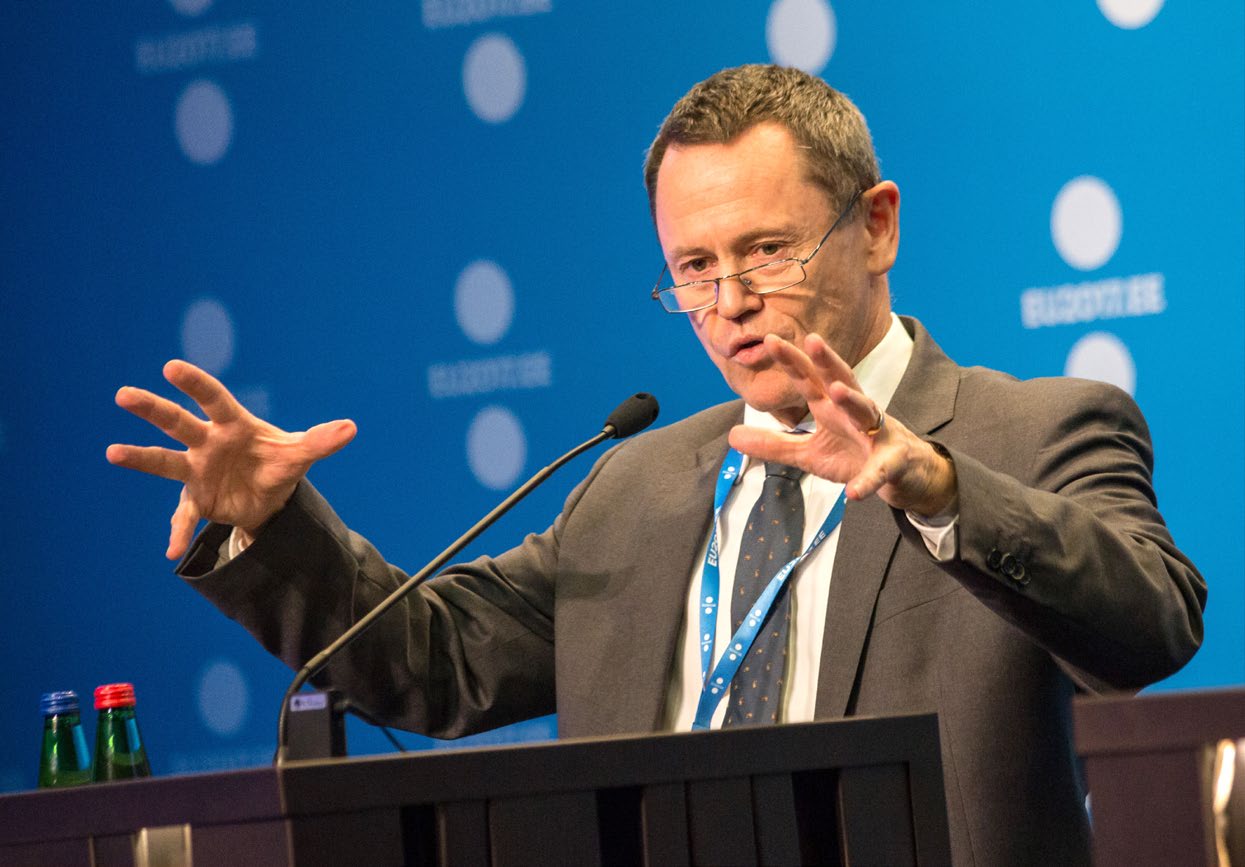
Simon Upton, New Zealand’s paliamentary commissioner for the environment, speaking at an informal meeting of environment ministers. Photo: Aron Urb (EU2017EE).
In 1996, the Greenhouse Policy Coalition formed to represent major emitters, including Coalcorp, Carter Holt Harvey, NZ Steel, Comalco, and oil refining and cement companies. It lobbied ministers against the carbon tax and asserted that its members should be part of any policy development.
Guy Salmon, who had spearheaded a public campaign that led to the creation of the Department of Conservation, was a WOGOCOP member. He went on to help found the blue-green political movement and is now director of the Ecologic Foundation, an environmental think tank. He says that downright climate denial, which played a significant role in the US, never really took hold in New Zealand. “The real problem was that we have built into our culture an unwillingness to take responsibility for these things and have a very strong deference to vested interests. Those are two factors that have characterised the entire period.”
The carbon tax was put on hold in the lead-up to the 1997 climate summit in Kyoto. The next year, National lost the election. “WOGOCOP was a wasted effort,” says Salmon, who sees the failure to bring in a carbon tax as the first in a series of “kill-off moments”.
But during this period, Upton took a step which he calls “one of the most remarkable things I did”. He used the new Resource Management Act to intervene in a proposed expansion of the state-owned Stratford power station in Taranaki. A board of inquiry concluded that the station would jeopardise New Zealand’s reduction target and ruled that it could only go ahead if enough trees were planted to offset the extra carbon. “It was the first time,” Upton says. “It seemed logical that if you’re going to have a massive gas-fired power plant you have to mitigate it somehow.” (In 2003, the Taranaki Regional Council granted an application to scrap the mitigation requirement.)
By the end of 1997, forest offsets had become an important element of climate policy for New Zealand. But they turned out to be a double-edged sword. The Kyoto Protocol bound wealthy countries to individual targets. Some countries agreed to stringent cutbacks. In contrast, Australia negotiated to stay 8 per cent above its 1990 emissions, arguing that they had “a rapidly expanding population and a lot of immigration, and not much scope to reduce industrial emissions”, remembers Ralph Chapman, an economist at Victoria University of Wellington, who was one of Upton’s policy advisers and part of New Zealand’s negotiating team.
New Zealand returned from Kyoto with what Chapman describes as “a reasonable deal” to bring emissions back to 1990 levels, which, he explains, “we only achieved because of our forestry”. New Zealand wound up relying on forest sinks and emissions trading with other countries to meet its target — with the consequence of no real cuts in gross emissions.
Even at the time, Upton argued that forestry was at best a short-term fix. In his mind, offsets were a way to buy time to develop more powerful tools, including an emissions trading scheme. “Except we didn’t. We spent 25 years after that doing virtually nothing.”
In its June advice to government this year, the Climate Change Commission concluded that while forest plantings have contributed significantly to meeting targets in the past, their benefits “are now coming to an end”. Commercial forests are being harvested and will release the stored carbon back into the atmosphere, the commission warned. “As a country, we are now in a position that is much more difficult than it might have been, if we had acted with more regard to the future”.
Busloads of farmers were heading into Wellington from all over the country to join others rumbling down Lambton Quay in their tractors. It was September 2003, and they were headed for the Beehive to register their outrage at what had become known as the “fart tax”. The demonstration culminated with former National MP and Taranaki farmer Shane Ardern gunning a vintage Massey Ferguson he called Myrtle up the Parliament steps.
New Zealand has an unusual emissions profile among developed countries. Almost half (48 per cent) of our total greenhouse gas emissions comes from agriculture, mostly in the form of methane from burps (not farts) of cows, sheep and deer. Our carbon dioxide emissions come largely from the energy, manufacturing and transport sectors. Emissions from electricity generation are low because New Zealand has long relied on renewable sources such as hydropower, but we continue to use coal for industrial heat and fossil fuels in transport. Transport and agriculture are the fastest growing sources of emissions, but agriculture has never been included in any emissions pricing or other regulations on greenhouse gases. It remains exempt until at least 2024.
The issue came to a head in 2003, when the Labour-led government under Prime Minister Helen Clark was considering a tax on emissions from fossil fuels and industrial processes. MP Pete Hodgson convened a ministerial group on climate change, although he held so many overlapping portfolios that officials joked he would only need to discuss the matter with himself. Hodgson had no intention of including agriculture in a carbon tax. But as a former vet, he was keen for the sector to bring down its methane emissions via scientific solutions. When he announced a mandatory levy on farmers to boost such research, that’s when the tractors revved up.
The government backed down on the mandatory levy. Instead, it contributed dollar-for-dollar to an industry-led research consortium. Since then, there’s been progress on breeding low-emission sheep. But while a methane-inhibiting feed additive is close to becoming available for Europe’s intensive beef and cattle farms, it’s still some time before anything like this could be used for New Zealand’s more free-ranging, pasture-fed livestock.
“We should have invested multiple times more money,” says Climate Commission Chair Rod Carr. “We’ve paid lip service to the amount of investment that would be required to find that technology and deploy it at scale quickly. This is a sector that earns us $30 billion a year in foreign exchange and we should be spending billions fixing this problem, not tens of millions.”
The fart tax furore also had repercussions for the carbon tax. In the end, the government didn’t have the numbers to bring it in. It continued to work on voluntary agreements with individual companies while it developed an emissions trading scheme. This eventually passed under urgency just before the 2008 election, which Labour lost. The government changed once again.
New Zealand’s emissions trading scheme (ETS) was the first in the world to — at least in theory — cover all sectors of the economy and all six greenhouse gases in the Kyoto Protocol. The responsibility for emissions was with polluters at the highest point of production — for example, fuel importers rather than people putting petrol in their cars.

Former National MP Shane Ardern driving a tractor up Parliament steps during the anti-fart tax protest by farmers in September 2003. Photo: New Zealand Herald.
The fundamental idea sounded simple enough. A certain number of carbon credits is released into the market, capping the allowable amount of emissions each year. For every tonne of emissions, emitters must surrender a tradable unit back to the government. If emissions are higher than the number of credits released, the rising demand for units pushes up their price. This should in turn encourage polluters to invest in reducing their emissions, rather than paying more for them. That’s how it was meant to work, but the reality is far more complex.
When National returned to power in 2008, the ETS was coupled with the Kyoto Protocol’s international carbon markets and global carbon price, which meant New Zealand could trade with other nations. That, with hindsight, “turned out to be completely wishful thinking”, says Suzi Kerr, chief economist for the Environmental Defense Fund in New York.
Back then, Kerr was the founding director of the public-policy institute Motu, which she had set up in 2000. But she’d been thinking about how tradable-permit markets could be used to tackle environmental problems for more than a decade, by then, since completing her doctoral research on the subject at Harvard University in 1995.
“We were assuming, quite naively, that other [countries] would be doing this in a sensible way and we would just want to be aligning our emissions effort with their emissions effort, and we would all have similar prices,” she recalls. There was also an expectation that Kyoto would quickly be followed by more climate agreements and that emissions would be properly monitored. “We never got that for the Kyoto Protocol.”
Another unexpected setback came when the Soviet Union disintegrated, plunging countries in the Eastern Bloc into economic crisis. Their industrial emissions dropped far below 1990 levels, creating an abundance of empty “hot air” credits. Other countries, including New Zealand, snapped them up to offset their emissions. The carbon price plummeted. For a time, trading units were worth less than a dollar, down from an initial $20.
“We were assuming, quite naively, that other countries would be doing this in a sensible way.”
The National Party under Prime Minister John Key changed the ETS radically. Instead of a capped number of units, an infinite number was released at a price of $25. Without the cap on units, there was no clear limit on emissions. National also introduced a two-for-one option, which meant each unit was now worth two tonnes of emissions. Agriculture’s entry was postponed indefinitely.
New Zealand never had a leading politician who denied climate change, although climate sceptics played a significant role in delaying decisions and sowing doubt. Key formed a government with confidence-and-supply support from ACT, United Future and the Māori Party, and in February 2010, ACT leader Rodney Hide launched an attack from Parliament on NIWA’s long-standing temperature record.
NIWA had published the results of temperature changes at monitoring stations between Auckland and Dunedin. It showed that between 1909 and 2008, New Zealand had warmed, on average, by 0.9°C. Hide’s real target was the ETS. But he used what he called NIWA’s “shonky” science to drum up public opposition.
David Wratt was NIWA’s chief scientist for climate, as well as representing New Zealand on the IPCC bureau. He remembers repeatedly being side-tracked from his actual job because he had to draft answers to about a hundred often-repetitive parliamentary questions. His work was put on hold almost entirely when the newly formed New Zealand Climate Science Education Trust took NIWA to court over its temperature data. The trustees were all members of the New Zealand Climate Science Coalition, which had received a US$25,000 grant from the Heartland Institute, a key player in organised climate denial in the US.
In 2012, the High Court dismissed the trust’s challenge, highlighted the lack of expertise of some of its members, and ordered it to pay $89,000 in costs. The court proceedings consumed three years in which Wratt’s team could have instead focused more fully on research to develop climate models for the New Zealand region. Even a decade later, relaxed in semiretirement, Wratt seems weary just remembering this period. “It really did get to me at times,” he recalls.
Both the fart tax episode and the court case politicised climate science and succeeded in confusing people and polarising public opinion.
In 2016, in response to a question in Parliament by Greens co-leader James Shaw, John Key declared New Zealand would be a fast follower, not a leader, on climate change. The phrase came from a 2007 report published by the New Zealand Institute called We’re Right Behind You. “Acting to be a world leader with respect to emissions reduction is inappropriate for New Zealand”, the report submits, recommending that New Zealand should instead move quickly to adopt measures based on what happens elsewhere.
New Zealand’s self-image as a trailblazing nation is built on historic leaps like universal suffrage and the anti-nuclear stance. But David Hall, a political scientist with a focus on climate policy, points out that those progressive leaps were usually triggered by a crisis, punctuating New Zealand’s otherwise reactive policy style. “A reactive approach isn’t so useful in climate change, of course, because so much of what needs to be done is pre-emptive.”
The zero carbon law is the most significant development in the last five years on the climate front. It provides a clear sense of what New Zealand needs to achieve. And it’s notable that the driver for this legislation came from outside government — from younger generations changing the thinking about climate change from an environmental issue to one of inter-generational justice and fairness.
In 2010, at the age of 25, Paul Young was part of a youth delegation at the COP-16 climate-change meeting in Cancun. A year earlier, talks in Copenhagen had failed, and the Cancun meeting also ended without a meaningful agreement. The frustration about the failure of UN negotiations prompted some in the group to focus on climate action back home.
Seven of the 12 young people from New Zealand who’d attended Cancun set up Generation Zero to “reclaim their future” and raise awareness of the cost and consequences of further delays for younger generations. “Things were bleak,” remembers Young, a physicist turned climate modeller who is now a senior analyst with the Climate Change Commission. “Interest in the topic had really dwindled and in the early years we found it hard to get any sort of cut -through.”
General awareness of climate change was low, Young says, and even mentioning it was often a conversation stopper. Among those who were thinking about it, a sense of apathy and helplessness was pervasive. But things began to change in the lead-up to the 2015 climate summit in Paris.
The following year, Generation Zero began a campaign to develop a comprehensive plan to get New Zealand to zero greenhouse-gas emissions and drafted what would eventually become the Zero Carbon Act. As the proposed legislation was making its way through Parliament during 2019, tens of thousands of New Zealand students joined the global school-strike movement, calling for decisive action on climate change. When the act was passed in November 2019, with support from all MPs except Act leader David Seymour, James Shaw thanked Generation Zero for elevating climate change policy “beyond petty politics and partisanship, to transform a problem so wicked and so stuck that we have made virtually no progress on it in the 30 years we have been aware of it”.
One of the law’s requirements was a new Climate Change Commission. When Rod Carr was appointed as the commission’s first chair, he was 62 and meant to be easing his way into retirement. When the former deputy governor of the Reserve Bank and the vice chancellor at the University of Canterbury during the earthquakes talked over the idea with his family at the dinner table, his children couldn’t understand why he was hesitating. His youngest son, who’s currently adding a master’s in ecology to his software engineering degree, told him he should quit all his other responsibilities “because there’s only one job you should do”.
Trained at some of the world’s best business schools, Carr had no previous background in environmental issues. He went through an 18-month process of intensive learning, which left him “slightly disappointed” in himself, he told Stuff. “I do say, ‘Where have I been for the last 30 years.’ This stuff was known.” At his son’s urging, he bought an electric car and has since covered his roof with solar panels.
Carr has been refreshingly frank when addressing the issue. Speaking at a conference about climate change and agriculture earlier this year, he argued that all the delays have changed the economic landscape for New Zealand’s pastoral agriculture. He sees real threats, especially for red meat, coming from changing consumer preferences and border-tax adjustments by countries that have invested in reducing their own emissions and will look to penalise products from those that haven’t.
Carr is also very clear that market forces alone won’t achieve the transition required. “Coming out of the 1990s, we may have had a predisposition to believe that price alone could do the work. The rest of the world never really believed that,” he says. “We, in the 1990s, had very limited regard for regulatory economics or policy. We were able to ridicule it and belittle it because it had not served us well, in its former manifestation.” He points out that “most economies in the Western world” use both prices and government regulations to “create better outcomes for society”.
A decade after the launch of Generation Zero, Paul Young feels “hugely hopeful” about the global trajectory on climate change. “At the surface, when we look at some of the headline metrics like global emissions, it doesn’t look to be that much cause for hope, but actually, when you look under the hood, there is the start of a period of really rapid and disruptive change happening.”
“As an older person, I can empathise completely with what it’s like to be a young person and to have this dread.”
At 76, Dave Lowe has published his biography The Alarmist this year and still serves as a mentor for the school climate strikes movement. He joins strikes regularly and works particularly closely with students at his local high school. He still easily reconnects with his own younger self, chasing the waves with his longboard. The memory of when he first realised the implications of planetary warming remains vivid. “I was horrified. And so now, as an older person, I can empathise completely with what it’s like to be a young person and to have this dread.”
In March this year, James Shaw rang the bell at the New Zealand Exchange to kick off the first auction of carbon credits under the Emissions Trading Scheme, following amendments he’d initiated to make the scheme work as originally intended. The ETS now operates through regular auctions of a limited number of units, effectively capping emissions. The aim is to “bend the curve of our emissions downwards, something that has never happened before in our country”, Shaw said at the time.
From January 2022, new regulations will bring in fines of up to $6,000 for any ETS participants who fail to submit an emissions return. But the ETS is no longer the only tool. A suite of new policies, from the billion-tree planting programme to a $100 million green investment fund and incentives for electric cars, are now in place to help shunt New Zealand toward emission cuts.
For Upton, the main point is simply to get on with it. “It’s all very ambitious to say net zero by 2050. That is unquestionable — and even forget the net bit, we need to be at zero carbon at 2050. But just make some progress, that would be better than having aspirations we never meet. For me the jury is still out. There’s a promising framework and a promising process, but ultimately the test is whether emissions come down.”
Veronika Meduna is a science/environment writer and editor based in Wellington. (Disclosure: She is married to Andy Reisinger, who is currently a member of the IPCC bureau and principal scientist climate change at the Ministry for the Environment.)
This story appeared in the October 2021 issue of North & South.

